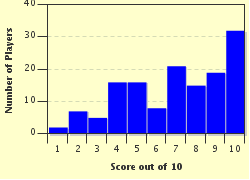Quiz Answer Key and Fun Facts
1. Whether a law, rule, tradition or accepted custom, one practice affected history in most of the Old World for hundreds of years to varying degrees. What was it called?
2. The original name of the Knights Templar was 'Poor Fellow-Soldiers of Christ and of the Temple of Solomon'. During what period did the order flourish?
3. Though the Order of the Knights Templar became wealthy and powerful, the knights were under strict vows. These were primarily what?
4. What was considered the primary goal of the Knights Templar?
5. When a man became a Knight Templar, he was already a skilled warrior, and of a mature age and nature. His worldly goods would be donated to the order as would his future. In a few cases, married men were allowed entry but only if they had what?
6. During their reign, the Order of the Templars became wealthy and developed a system that became convenient and popular throughout Christian cultures. What did this involve?
7. The founder of the Knights templar was Hugues de Payens around 1119, and he was the first Grand Master, an office held for life, though in those times it might be a short one. He and the Patron designated the white mantle at the Council of Troyes in 1129. Who was the Patron?
8. The last Grand Master of the Knights Templar was Jacques de Molay. He was burned at the stake in 1314 by whose decree?
9. In 2001, a document was discovered in the Vatican Secret Archives by historian Barbara Frale, dated August, 1308. Before the Knights Templar were disbanded in 1312, Pope Clement had done what?
10. What was the pictorial symbol used by the Knights Templar?
Source: Author
alexis722
This quiz was reviewed by FunTrivia editor
bloomsby before going online.
Any errors found in FunTrivia content are routinely corrected through our feedback system.

